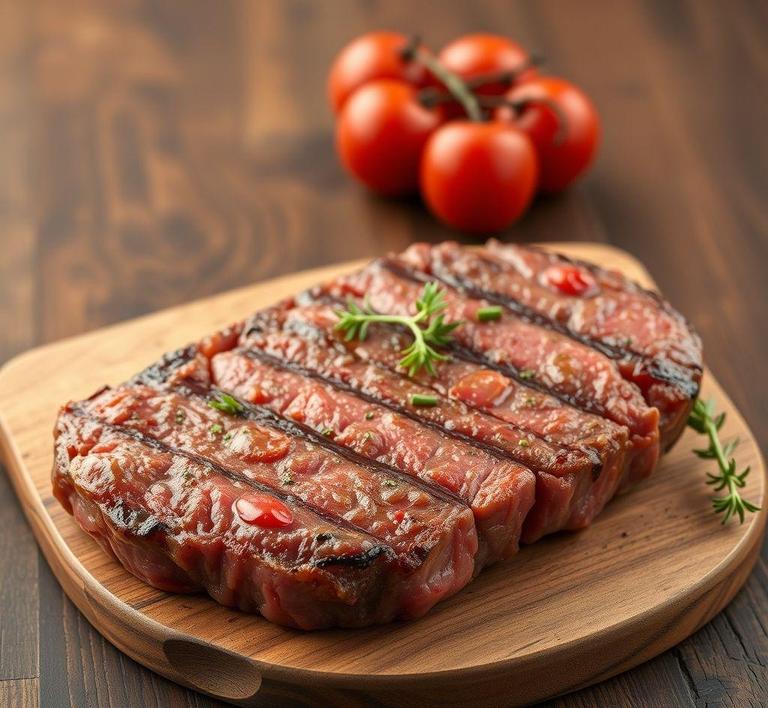Refreezing beef steak is a topic that often sparks confusion and debate. While it’s common to freeze beef for preservation, many wonder if it’s safe or advisable to refreeze a steak once it’s been thawed. The good news is that, with proper handling, refreezing beef steak can be done safely without compromising too much on quality or taste. However, it’s important to understand the key steps to ensure the meat stays fresh and safe to eat, and what mistakes to avoid. In this guide, we’ll walk you through the do’s and don’ts of refreezing beef steak, so you can enjoy your steak even after a second freeze.
Can You Refreeze Beef Steak?

Beef steak, like other types of meat, is something many of us enjoy on a regular basis. It’s versatile, delicious, and can be cooked to different levels of doneness, making it a beloved staple in kitchens around the world. But what happens when you find yourself with leftover beef steak, and you’re not sure whether you can freeze it again? Can you refreeze beef steak, and if so, what are the risks involved?
The short answer is yes, you can refreeze beef steak – but it’s important to understand the nuances surrounding this process. Refreezing beef steak isn’t a straightforward decision that can be made without considering factors like how the steak was stored, whether it’s been cooked or raw, and how long it was kept in the freezer initially.
When beef steak is frozen and then thawed, the muscle fibers and tissue begin to break down, which is part of the reason why frozen and thawed meat may lose some of its original texture and flavor. Refreezing the meat after it has thawed leads to additional moisture loss and changes to the texture, making it less ideal for future use, especially if the steak was thawed and left out at room temperature for an extended period.
However, as long as the beef steak has only been thawed in the refrigerator (keeping the meat at safe, controlled temperatures), it is generally safe to refreeze. The key here is maintaining the meat at temperatures below 40°F (4°C) during the thawing process and limiting the time it’s in the danger zone – which, according to food safety guidelines, is between 40°F and 140°F (4°C to 60°C).
The main thing to watch out for is the potential for bacterial growth. If the steak was thawed at room temperature or left out too long, refreezing is not recommended as bacteria can multiply rapidly in warmer conditions, which increases the risk of foodborne illness.
How To Refreeze Beef Steak?
Refreezing beef steak is a process that requires careful attention to detail, especially to avoid compromising its quality or safety. Here’s a step-by-step guide on how to do it properly:
- Thawing Properly: If you plan on refreezing beef steak, it must first be thawed safely. The best way to thaw beef steak is in the refrigerator. Allow it to thaw slowly and evenly in a sealed container to prevent any leakage or contamination from other foods. This can take anywhere from a few hours to a day, depending on the size of the steak.
- Check the Steak: Once the steak has thawed, check it for any signs of spoilage. Fresh beef should have a firm texture, a vibrant red color, and a mild odor. If the steak has any off-putting smells, a slimy texture, or any discoloration, it may have spoiled and should not be refrozen.
- Wrap It Properly: Once you’re ready to refreeze the steak, ensure that it is tightly wrapped to avoid freezer burn. Use either plastic wrap, foil, or a vacuum-seal bag for best results. If you’re using a regular freezer bag, remove as much air as possible before sealing. This will help to preserve the meat’s moisture and prevent freezer burn.
- Label and Date: Always label the steak with the date of refreezing. This will allow you to track how long it has been in the freezer, and ensure you’re using it within a reasonable timeframe.
- Freeze Immediately: Place the wrapped steak in the coldest part of the freezer. Make sure that the temperature is set to 0°F (-18°C) or lower to preserve the steak’s quality and prevent bacterial growth.
Quality Impact
While refreezing beef steak is technically safe when done correctly, there’s no getting around the fact that the process will affect the quality of the meat. There are several factors that play a role in this:
- Texture: Beef steak, like other meats, is primarily composed of muscle fibers. When meat is frozen, ice crystals form within the cells. Upon thawing, these crystals melt and may cause some of the moisture in the steak to leak out, which leads to a loss in juiciness and tenderness. Refreezing the steak after thawing exacerbates this issue, making the steak potentially drier and tougher the second time around.
- Flavor: Freezing and thawing beef multiple times can cause the meat to lose some of its original flavor. This happens because the cellular structure breaks down with each freeze-thaw cycle, and the steak may become more bland or lose its rich, meaty taste. The natural flavors of the beef may become diluted, making it less enjoyable when it is cooked later.
- Freezer Burn: One of the biggest quality issues associated with refreezing beef steak is freezer burn. Freezer burn occurs when air comes into contact with the surface of the meat, causing dehydration and oxidation. This results in off-flavors, changes in texture, and an unpleasant appearance. Although freezer-burned steak is still safe to eat, it may not be as appealing.
- Nutrient Loss: Freezing and thawing can lead to some loss of nutrients, particularly water-soluble vitamins like B-vitamins. While this loss is typically minimal, the more times you freeze and thaw the steak, the greater the risk of degradation in its nutritional profile.
While refreezing beef steak is possible and generally safe if done properly, it does come with some caveats. For the best results, always ensure that the beef has been thawed safely and stored correctly. Refreezing can lead to changes in texture, flavor, and overall quality, so it’s important to weigh the pros and cons before deciding to refreeze. If you do choose to refreeze beef steak, be sure to handle it with care by wrapping it well, labeling it for future use, and freezing it promptly.
If you’re someone who doesn’t mind slight changes in texture or flavor, refrozen steak can still be a perfectly good meal – especially in dishes where the steak will be cooked down, like stews, tacos, or stir-fries. However, if you’re looking to enjoy a perfectly juicy and tender steak, it’s best to consume it shortly after thawing to preserve its original quality. Ultimately, how often you refreeze beef steak will depend on your personal preferences and how carefully you handle the meat during storage and preparation.
Is It Safe To Refreeze Beef Steak?
Refreezing beef steak, like other cuts of meat, is a topic that has sparked debate among both culinary enthusiasts and food safety experts. The safety of refreezing beef steak primarily hinges on how it was handled in the first place and whether it has been thawed properly. In general, it is safe to refreeze beef steak as long as it has been kept at the correct temperature during the initial thawing process. However, there are a few important conditions to consider to ensure both safety and quality.
The Thawing Process
When you thaw beef steak, it should be done in the fridge or under cold running water, never at room temperature. This is because meat that is thawed at room temperature can enter the "danger zone" (40°F to 140°F or 4°C to 60°C), where bacteria multiply quickly. If the beef steak has been thawed in the refrigerator and hasn’t been left out for more than a couple of hours, it’s generally safe to refreeze. However, if the beef has been left out at room temperature for longer than two hours (or one hour if it’s above 90°F/32°C), it’s better to discard it to avoid foodborne illness.
The Quality Aspect
While it may be safe to refreeze beef steak, the quality of the steak will likely deteriorate with each freeze-thaw cycle. Beef steak is already a perishable item, and freezing can cause the muscle fibers to contract, leading to a loss of moisture and a change in texture. The more you freeze and thaw, the more likely it is that the steak will become dry, tough, and less flavorful. In most cases, it’s best to freeze the steak only once if you plan on preserving its flavor and texture.
Signs That Beef Steak Should Not Be Refrozen
Even if you’ve followed proper thawing protocols, there are certain signs to look out for that indicate the beef steak should not be refrozen. Refreezing beef with these characteristics can be harmful to both safety and quality:
1. Off Or Foul Smell
Beef steak that has gone bad will have a strong, unpleasant odor. This is the most obvious sign that the meat has spoiled and is unsafe to refreeze. Fresh beef should have a slight metallic or iron-like smell, but if it has a sour or rotten odor, discard it immediately. The bacteria that cause spoilage are likely to proliferate when thawed and refrozen, posing a significant health risk.
2. Slimy Or Sticky Texture
Another indication that beef steak should not be refrozen is a slimy or tacky texture. Fresh beef should have a firm, slightly moist texture. If it feels slippery or sticky to the touch, this could be a sign of bacterial growth, which makes it unsafe to refreeze.
3. Discoloration
Fresh beef is typically deep red or pink in color. If your beef steak has turned brown, grey, or has any unusual discoloration, it could be a sign that the meat is deteriorating or has been improperly stored. While slight color changes can occur when meat is exposed to air, drastic discoloration generally indicates spoilage.
4. Freezer Burn
While not necessarily harmful, freezer burn is a sign that the beef steak has been frozen and thawed multiple times, leading to dehydration and poor quality. The presence of freezer burn means that the beef has been exposed to air inside the freezer, causing the meat to lose moisture and develop dry, tough areas. Freezer-burned beef steak will still be safe to cook, but it will be less desirable in terms of flavor and texture.
Common Refreezing Mistakes
Despite the general guidelines, many people make mistakes when it comes to handling beef steak for refreezing. Understanding these common pitfalls can help you avoid ruining both the safety and quality of your steak.
1. Thawing At Room Temperature
One of the most common mistakes people make is thawing beef steak at room temperature. As mentioned earlier, meat should never be thawed outside of a controlled environment like the refrigerator or under cold running water. Room temperature thawing allows bacteria to multiply quickly, increasing the risk of foodborne illness.
2. Refreezing Multiple Times
Each time you freeze and thaw beef steak, you risk further deterioration of its texture and flavor. It’s best to refreeze beef steak only once after it has thawed. Each cycle will cause moisture loss and impact the overall quality. Refreezing beef multiple times makes it increasingly tough, dry, and less enjoyable to eat.
3. Refreezing Beef That Was Not Fully Cooked Or Properly Stored
If you cooked the beef steak and then froze the leftovers, it’s important to ensure that it was stored properly and cooled quickly before being frozen. Leftover beef steak should be wrapped tightly in airtight packaging, such as plastic wrap or aluminum foil, and placed in the freezer within two hours of cooking. This will prevent bacterial growth and ensure that it stays safe for refreezing.
4. Not Labeling Frozen Meat
A simple mistake, but one that can lead to issues down the road: not labeling your beef steak with the date it was frozen. Proper labeling allows you to track how long the steak has been in the freezer, so you know when it might start losing its quality. Ideally, beef steak should be used within three to four months of being frozen for optimal taste and texture.
Tips And Tricks
If you find yourself needing to refreeze beef steak, here are some tips to help maintain both the safety and quality of the meat:
1. Freeze Beef Steak In Smaller Portions
If you plan on refreezing beef steak, it’s a good idea to freeze it in smaller, individual portions. This way, you can thaw only the amount you need, reducing the need to refreeze larger cuts multiple times. Smaller portions are also easier to defrost evenly, minimizing the risk of bacteria growth.
2. Vacuum Seal The Beef
Vacuum sealing beef steak before freezing it will help to protect it from air exposure, preventing freezer burn. This airtight seal keeps moisture in, ensuring that the steak retains its flavor and texture even after refreezing. If you don’t have a vacuum sealer, you can wrap the steak tightly in plastic wrap, followed by aluminum foil, to reduce air exposure.
3. Store Beef Steak In The Coldest Part Of The Freezer
To maintain the best quality when freezing beef steak, store it in the coldest part of the freezer, ideally at 0°F (-18°C) or lower. This helps preserve the meat’s texture and flavor for a longer period, minimizing the degradation process.
4. Thaw Beef Steak Slowly
When you are ready to thaw your beef steak, do so slowly by transferring it to the refrigerator 24 hours before you plan to cook it. This helps maintain its texture and prevents any part of the meat from entering the danger zone of bacterial growth.
Conclusion
In summary, refreezing beef steak is safe under the right circumstances, particularly when it’s been thawed properly and hasn’t been left out at room temperature for extended periods. However, it’s important to understand that while refreezing might be safe from a food safety perspective, it can lead to a significant loss in quality. The texture and flavor of the steak will degrade with each freeze-thaw cycle, making it less enjoyable to eat.
To maximize both safety and quality, it’s crucial to handle beef steak properly before freezing it, avoid refreezing multiple times, and follow tips like freezing in smaller portions or vacuum sealing. Always keep an eye out for signs of spoilage, like an off smell or slimy texture, as these are clear indicators that the steak should not be refrozen. By following these guidelines, you can ensure that your beef steak remains as safe and delicious as possible.


